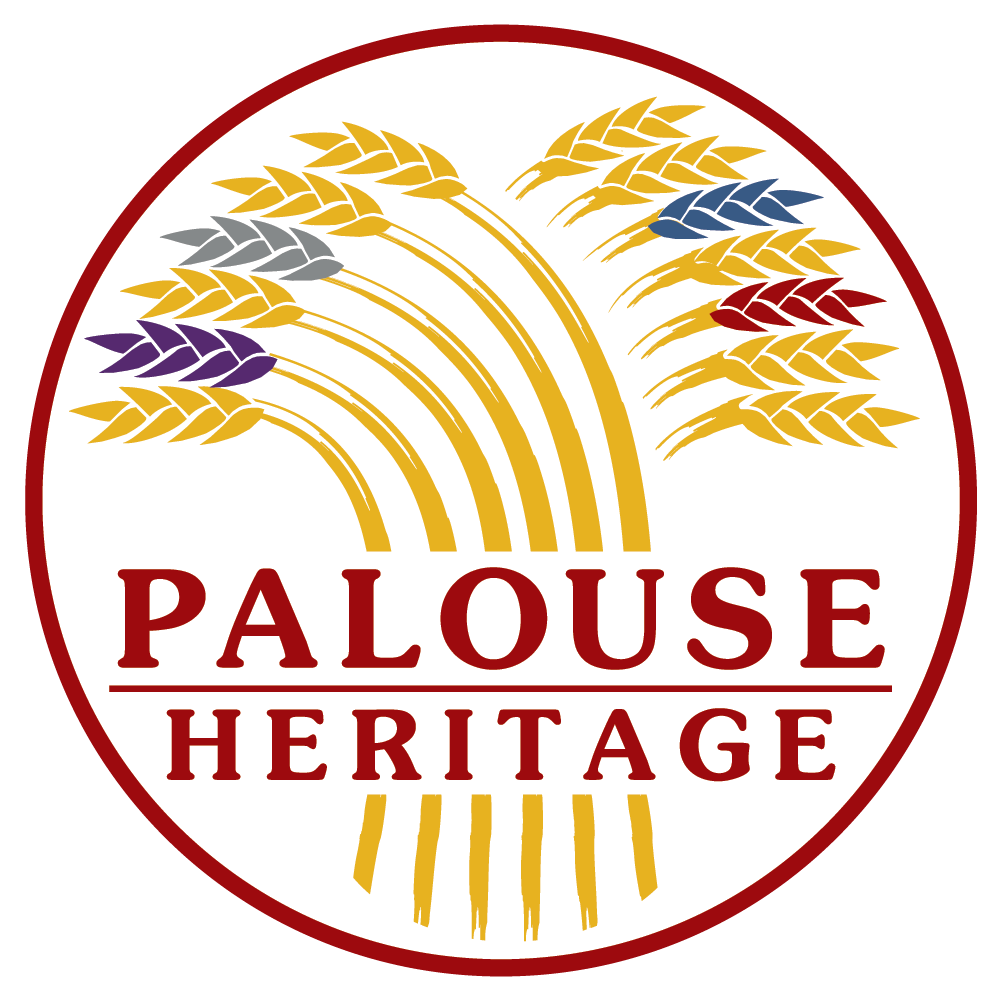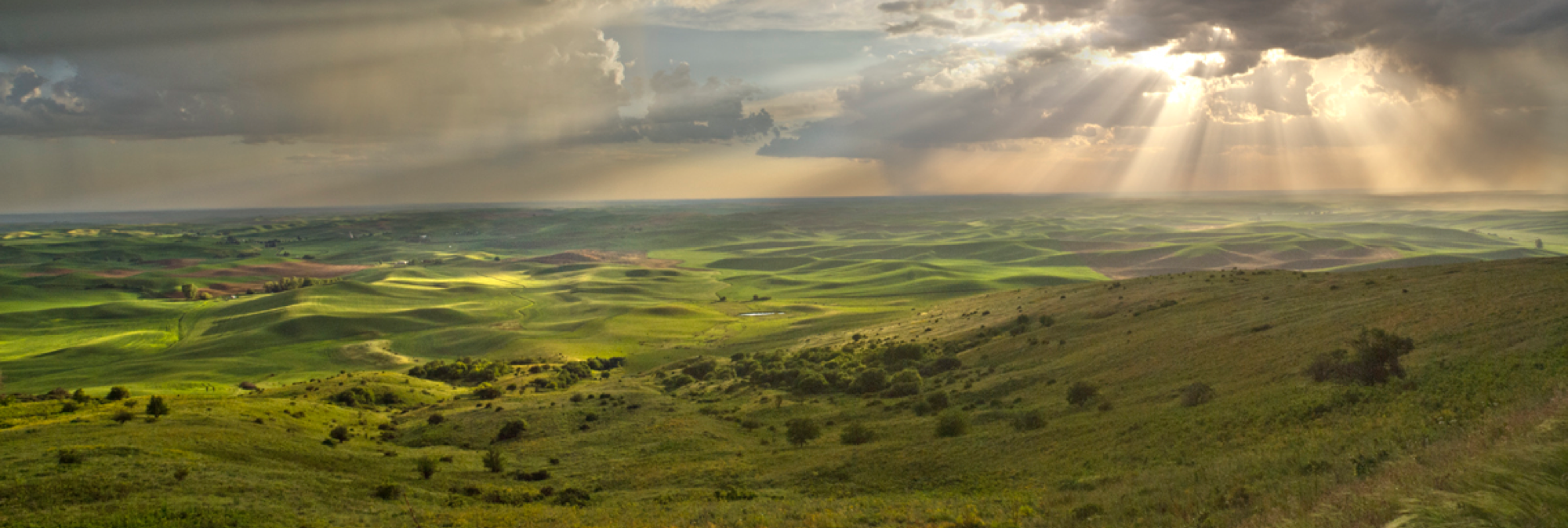Even after great holiday sales, we remain well supplied with our Palouse Heritage Sonoran Gold pastry flour as well as our long awaited Crimson Turkey bread flour, known back in the day as “Turkey Red” though it ancestral homeland is actually south Russia and Ukraine. Until this flavorful grain was introduced to the United States in the 1870s, virtually all bread in the country was made from soft white wheats and other grains more suited for making biscuits, pancakes, and flatbreads. Our crop yielded well and is already being used by several Northwest bakeries including Damsel and Hopper Bakeshop in Seattle, Ethos Bakery in Richland, and Culture Breads in Spokane.
Palouse Colony Heritage Grain and Transfering from Wheat Truck to Totes
Two venerable elders now in their nineties and familiar with Crimson Turkey were raised on farms near our Palouse Country hometown of Endicott. Don Schmick and Don Reich now reside in neighboring Colfax, and I recently asked them about it. “That’s the grain we saved for our own use!” Don Reich recalled. “There’s nothing in the world that makes a bread so satisfying as flour from that wheat.” Don Schmick related a similar story and said that his immigrant farmer father made a annual trip every fall south of the Palouse River to the Pataha Flour Mill east of Pomeroy where the family’s precious Crimson Turkey wheat was ground into flour for the family’s needs throughout the year. Both men remembered that their mothers especially favored mixing about two-thirds of the wheat flour with one-third rye flour to make a delicious tawny-colored loaf that didn’t last long.
Joe navigating through a sea of Palouse Heritage wheat at DeLong Ranch (2017)
This past August we also returned to historic DeLong Ranch located several miles upstream from our Palouse Colony Farm and where we have worked for several years with neighbors Joe and Sarah DeLong to raise heritage grains. Joe’s ancestral connection to this scenic area is singular in significance to regional history as it is not only the oldest farm in the area, but also property that has been continuously farmed by the DeLong family since the late 1860s. Joe’s resourceful ancestor, also named Joseph DeLong, raised grain, extensive gardens, and livestock, and also planted an extensive orchard on fertile bottomland bordered by towering pines along the river. I have long been fascinated by the family’s remarkable saga and have written previously about it in previous blog posts and the book Palouse Country: A Land and Its People.
We’ve long been impressed by Joe and Sarah’s regard for the health of the soil and they have worked hard over the years to raise crops using natural rotation systems with minimum artificial inputs. The farm’s remote location also provides a rare glimpse into the “Palouse primeval.” Substantial virgin sod remains along both sides of the river that abounds with wildflowers in spring and summer and hosts deer, racoons, coyotes, eagles, and occasional meandering moose and elk. In addition to the landrace grains we raised this past year at Palouse Colony Farm, Joe and Sarah grew Red Walla Walla and Sonoran Gold wheats, and famed Purple Egyptian barley. Red Walla Walla is a rare soft red variety actually native to southern England that was traditionally used for biscuits, flatbreads, and for imparting a rich, tangy flavor to craft English wheat beers.
An unexpected adventure during this summer’s DeLong harvest was a visit to his family’s ancient grove of plum trees that are clustered at the foot of a grassy bluff close to the river. I had noticed the ripe purplish red fruit while riding the combine with Joe near the fence-line that separates the trees from the field. He informed me that the trees likely harkened back to the senior Joe DeLong’s time and contained four distinct varieties faithfully recorded in old ranch records—Bulgarian, Hungarian, Egg, and Petite.
DeLong Heirloom Plum Trees
Grandma’s Plum Delight
I mentioned seeing the trees at lunch time and Sara and Joe invited me to pick as many as I’d like since there were far more than their family could use. So armed with a large metal bucket from a nearby shed I ventured back to the spot in the hot afternoon and joined a herd of cows meandering through the plum trees. Indeed the trees were loaded with fruit and in no time my bucket was overflowing. I couldn’t tell a Bulgarian from a Petite but found that they all tasted wonderfully sweet. I had been staying in town with my sister and mother, and later that night when I reported on my discovery, Mom proceeded to tell me how to distinguish several kinds. The next day while I returned to the harvest field, she went to work making plum sauce as a topping for pancakes and breads, and also prepared “Plum Delight,” a crispy dessert with crumbly topping I remembered well from my youth. She agreed to provide me with her recipe which we share here with hopes it might grace your table sometime soon.
Plum Delight
Topping
- ½ cup Palouse Heritage Sonora flour
- ½ cup oats
- ½ cup brown sugar
- ⅛ teaspoon salt
- ¼ cup melted margarine
Filling
- 3 cups sliced plums
- 1 tablespoon Palouse Heritage Sonora flour
- 2 tablespoons sugar
- 1 teaspoon vanilla
- ½ teaspoon cinnamon
Preheat oven to 350 degrees. Combine plums, flour, sugar, vanilla, and cinnamon together in a bowl and put into ungreased 1 1/2-quart baking dish. Combine all topping ingredients in another bowl. Mix until crumbly and distribute over the plums. Bake in 350 degree oven for 45 minutes or until crispy and golden brown on top.




























